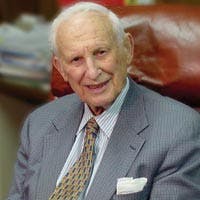"Test equipment [is] a service to the industry," says Julius Kendall, PE, CFPE and vice president of The Entwistle Co. - Kenett Hydraulic Distribution Div. His time in this industry has left him with more than just a history of his own, but the progress of GSE, especially that of test equipment.
Kendall began his aviation career as an Ensign in the US Navy after graduating Northeastern University in 1941 with a BS degree in Aerospace Engineering. While in the Navy he attended graduate school at Cambridge's MIT after which he was assigned to a Naval activity as Engineering Repair Officer. Kendall's career didn't focus on test equipment until WWII when he was reassigned to the Bureau of Aeronautics, Washington DC to become part of a division established to address the needs and requirements for use and maintenance of all types of Naval aircraft and engines after delivery from the original equipment manufacturers (OEM).
"First we had to determine from the manufacturers of the accessory components, hydraulics, fuel engine items, heaters, cabin pressurization, landing gear, etc., what [was] involved. They were most cooperative. We then had to determine who would be trained, their ratings, where and what would be needed to train these proposed mechanics and who would be the teachers," recalls Kendall.
Designs were drawn up for test equipment, and development began of training devices, such as textbooks, animated cartoon films from the movie industry and hands-on training. "Before long we had trained instructors, text books and specialized test equipment in all the schools. We also determined that [more] specialized schools [were] needed, such as electrical, hydraulic, instruments, etc. Establishing special rates for these mechanics also helped to identify their specialty and we could communicate directly with them," adds Kendall. "We prepared technical bulletins to keep them informed about the items being serviced."
Companies such as Greer Hydraulics, Denison Engineering, Sprague Engineering and many others including the aircraft and engine OEMs got involved to design and produce GSE test equipment, keeping pace as new innovations were installed on fighting aircraft during the war.
Moving to Commercial
Once the war was over, commercial airlines seized the opportunity to acquire many of the Military and Naval aircraft and expand their routes. The aircraft included the Navy R4D and R5D (DC-3 and DC-4) and several Curtis such as C-46, which used reciprocating engines with hydromatic type propellers, most rated 1,500 to 2,000psi.
Kendall saw the surplus GSE the military had used to support the aircraft being converted for commercial applications. "The most important items," says Kendall, "were portable hydraulic test units - either powered by electric motors or gasoline engines, [and] later ... diesel. The units were referred to as ‘mules' and were equipped with towbars for ready movement to the aircraft for testing the landing gear, flaps, etc."
Kendall soon joined Greer Hydraulics. In his new capacity he developed many types of test equipment both for the ramp and the shop. "We managed to standardize the equipment so that practically all airlines joined in and used the same equipment for the purpose intended," says Kendall. "This resulted in excellent test correlation and assured the airlines that the repairs were acceptable and safe."
Later when aircraft were equipped with jet engines rather than reciprocating engines a complete new range of test equipment had to be developed. "We engineered the specialized test equipment associated with the requirements for these different engines," adds Kendall. "This included requirements for testing fuel controls, after burner controls, flow dividers, pumps, etc."
Along with this surge in technology, the hydraulic systems changed. The systems' pressure rose to 3,000psi, started using non-flammable fluids and required special seals. Also the newer jets had more than one hydraulic system requiring the "mules" to be equipped with either dual or triple hydraulic circuits. Filtration was essential, leading to new ratings to meet requirements, BETA or Absolute, with ratings of 3 micron absolute a must. Keeping the hydraulic fluid cool also became essential and led to heat exchangers within the units, air cooled by fans since the units portability made water unavailable.
"A host of new companies entered the field of providing specialized test equipment to the Defense organizations and to the airlines. Many [of these] companies were established just to do overhaul work...," says Kendall.
Ultimately, the development of test equipment was a large step for the industry. It encouraged standardization and improved safety.





